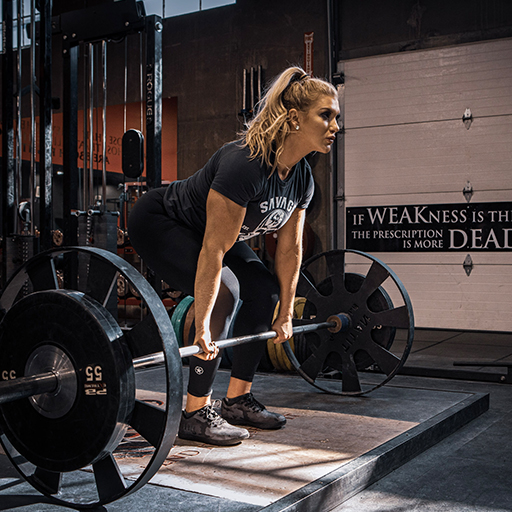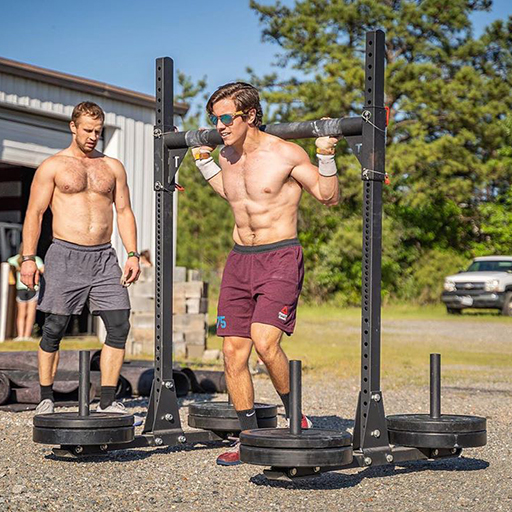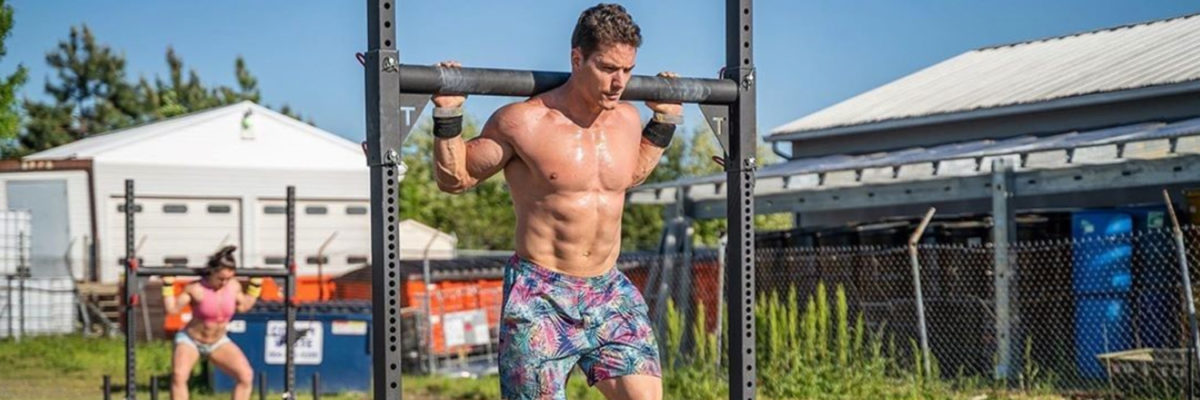In the world of weightlifting, the two words you’ll probably hear most often are “powerlifting” and “strongman.” Although you might see the terms used interchangeably, each refers to a specific type and weightlifting style. When comparing powerlifting vs. strongman, each offers different results and requires specific training routines.
Interestingly, when comparing powerlifting vs. strongman, you’ll find that both disciplines often use the same equipment, but it’s used differently. For example, powerlifters and strongman lifters use dumbbells, barbells, and power racks to achieve their strength and training goals. Fortunately for home gym users, much of this equipment can be used interchangeably for powerlifting and strongman routines.
Powerlifting and strongman are excellent fitness regimens and great for cardio, fat burning, and body sculpting. Plus, if you want to take your athleticism to the next level, both regimens allow you to compete at various achievement levels. If you’re considering powerlifting vs. strongman and wondering which style is right for you, here’s a look at 12 differences between these two classic weightlifting styles.

1. Powerlifting has its own specific goals
In powerlifting, the main goal is to increase your ability to lift the heaviest weights, using three primary lift techniques (which we’ll discuss below). Powerlifters typically use only a minimum of repetitions, motions, and movements to achieve this.
2. Strongman has different goals from powerlifting
With strongman training, the primary goals are to increase raw power, strength, and endurance. To accomplish this, it’s necessary to build muscle and stamina through more repetitions, as well as a variety of movements.

3. Powerlifting relies on basic resistance training
If you’re considering powerlifting vs. strongman, you’ll need to know what type of training is involved. Powerlifting depends primarily on resistance training to build up strength. This type of training often uses lower rep counts than strongman training, although the loads are still extremely heavy.
When lifting heavy barbells, it’s crucial to protect yourself from strain and injury. For ultimate protection, check out these Safety Squat Olympic Bars. They’re constructed with a built-in padded harness that enables you to lift more weight while decreasing the strain on your shoulders and back.
4. Strongman is based more on endurance and power
Strongman training focuses on activities that build core stability, strength endurance, and mighty functional strength. Toward this end, strongman training uses more reps and movements that might involve carrying or moving extremely heavy loads.
To increase raw power, strongman training sometimes requires different types of barbells that you might not find in a commercial gym. For example, these Axle Barbells from Titan Fitness are often used in strongman training. They weigh a comfortable 24 pounds yet have a hefty weight capacity of 880 pounds.
5. Powerlifting has specific key components
When looking at powerlifting vs. strongman, it’s essential to know that their primary components are fundamentally different. The key components of powerlifting are the squat, the bench press, and the deadlift. Throughout the training, the goal is to increase overall strength while performing these movements. As you build strength, you’ll want to invest in heavier barbells, such as these Blues City Power Bars. They weigh around 45 pounds. And have a weight capacity of 1,500 pounds. Thanks to their rigid design, they’re built to accommodate the extremely heavy weights necessary for competitive powerlifting.

6. Strongman uses different movement-based components
Unlike powerlifting, strongman relies heavily on crucial components such as pulling, pushing, and pressing heavy objects. This is because strongman competitions feature a wide range of specially created obstacle-themed events. In each of these competitions, lifters have to achieve lifts and carries, moving heavy objects to and from designated locations within a set time limit.
7. Powerlifting uses progressive overload training
Powerlifting uses a training technique known as progressive overload. To achieve this, you’ll want to increase your performance boundaries gradually. For example, if you can bench press 75 pounds on Monday, you’ll want to push it to 80 pounds in a later session.
Powerlifters use barbells with bumper plates to increase their weights. Bumper plates can be costly, but at Titan Fitness, we offer them at a wide range of affordable prices. For example, check out these LB Economy Bumper Plates, available in various convenient weight-coordinated colors.
8. Strongman uses progressive overload in a different way
Progressive overload techniques are also used in strongman training but are adapted differently. In strongman lifting, progressive overload can be readjusted by adding more reps, changing tempo and pace, and decreasing rest time, as your trainer recommends. In addition, strongman training includes a variety of movement exercises, including distance walking with heavy weights, hoisting logs overhead, and giant tire flipping.
For this type of specialized training, these EZ Curl Rubber Fixed Barbells are ideal for your home gym. They have built-in weights, so you can follow a progressive overload regimen without having to change plates.
9. Powerlifters aren’t typically as “shredded” as strongman lifters
When considering powerlifting vs. strongman training, you may have noticed that powerlifters usually don’t have the massive, muscle-heavy, “shredded” bodybuilder physiques like strongmen lifters. Of course, powerlifters can get a great physique with good muscle definition if they train hard enough. However, if you want a classic, Atlas-style shredded bodybuilder physique, strongman training is better for achieving those oversized, ripped muscles you see in the competitions.
10. Powerlifting competitions focus on three events
Powerlifting competitions focus on the three basic components of powerlifting: squats, bench presses, and deadlifts. The lifter is allowed three attempts in a typical competition, with a maximum single repetition for each lift. The most successful lift attempts are added to calculate the lifter’s final score.

11. Strongman has a wide variety of competitive events
Strongman has a designated roster of competitive goals and challenges designed solely for strongman events such as the World’s Strongest Man (WSM) competition. Here are some of the most popular strongman challenges:
Atlas Stones
Atlas Stones requires competitors to lift five heavy round stones, each weighing 220-352 pounds, and place them atop five high platforms along a course that’s 16-33 feet long. The contestant who completes the task in the least amount of time is declared the winner.
Farmer’s Walk
One of the most popular strongman events, Farmer’s Walk, requires competitors to walk at a specified distance while carrying extremely heavy items such as refrigerators. In some events, competitors often carry multiple items, weighing as much as 350 pounds.
Vehicle Pull
As the name implies, the Vehicle Pull involves the competitor wearing a harness and pulling a heavy vehicle with a rope. These vehicles typically include trucks, buses, train cars, and airplanes.
Deadlift
While most powerlifters know about deadlifts, the strongman version takes it to a new level. The lift is still done in one strong pull from the floor, but lifters must perform multiple repetitions of the move with extremely heavy weights. This shows off the lifter’s overall endurance as well as strength.
Fingal’s Fingers
Introduced comparatively recently in 2000, Fingal’s Fingers requires competitors to lift a series of progressively heavy hinged poles (or “fingers”), then flip them to the opposite side. As with many strongman events, the competitor who achieves the highest score in the shortest time is the winner.
12. Strongmen lifters often have coaches or trainers
While it’s not necessary to have a coach or a trainer to prepare for a strongman competition, the experts strongly advise having one. This is because each event has strict protocols and regulations that must be followed, and coaches can help competitors strategize these rules for maximum effect. Also, coaches can share time-honored techniques for achieving the highest possible scores on each event.
Special coaches aren’t as essential for powerlifters because the events aren’t as varied but focus on the three primary lifting techniques. However, a good coach or trainer can help you optimize your abilities, correct bad habits, and hone your technique to help you ace your next powerlifting competition.
Powerlifting vs. Strongman: Which should you choose?
The experts agree: Strongman training provides an excellent foundation for powerlifting. With the strength and raw power you’ll develop through strongman training, you’ll be able to transition into powerlifting easily. Likewise, the opposite is true — powerlifting can provide great muscle buildup to help you transition easily to strongman training.
Powerlifting vs. strongman: Which discipline is easier? To be honest, both have their challenges and advantages. However, if you’re using a commercial gym, you might not find some of the specialized equipment you’ll need for strongman training. For example, you’ll find the barbells and dumbbells needed for both disciplines, but you probably won’t have access to Atlas Stones.
That’s why lifters around the country know that the best way to train is to build your own home gym. You can customize your equipment and add specialized pieces you’ll need, such as this rugged Atlas Stone Platform from Titan Fitness. And if you decide to join the thousands of lifters who train for both powerlifting and strongman, you’ll be able to maintain the right equipment for both disciplines in your own customized home training space.
Whichever discipline you decide to pursue, Titan Fitness has you covered with a wide range of powerlifting and Olympic barbells, specialty bars, power racks, dumbbells, and just about everything else you need for your home gym. Titan Fitness offers premium quality equipment without the premium costs, so you’ll be able to equip your gym fully and still stay within your budget. Plus, Titan Fitness has free shipping on everything and offers a one-year warranty so that you can buy with confidence.
If you’d like to know more about buying the right equipment for your powerlifting, strongman training, or daily exercise routine, visit Titan Fitness. We’ll provide you with the equipment you need so you can create your dream gym at a price you can afford.


